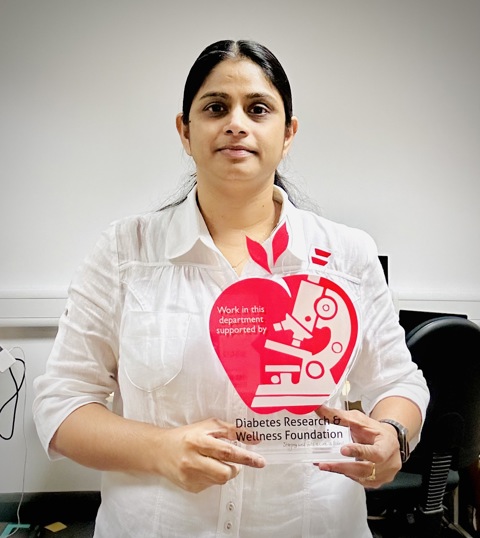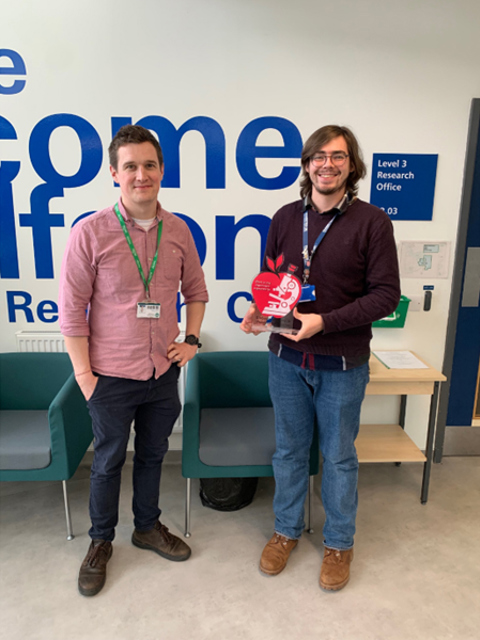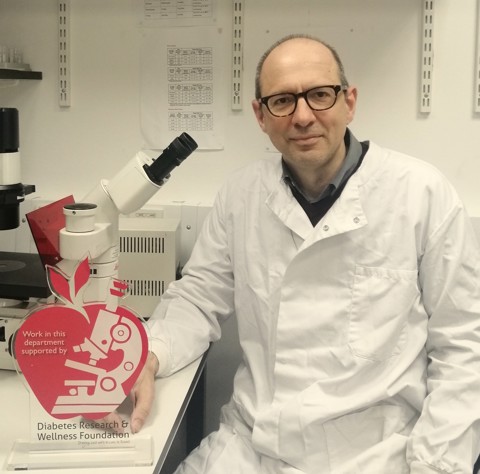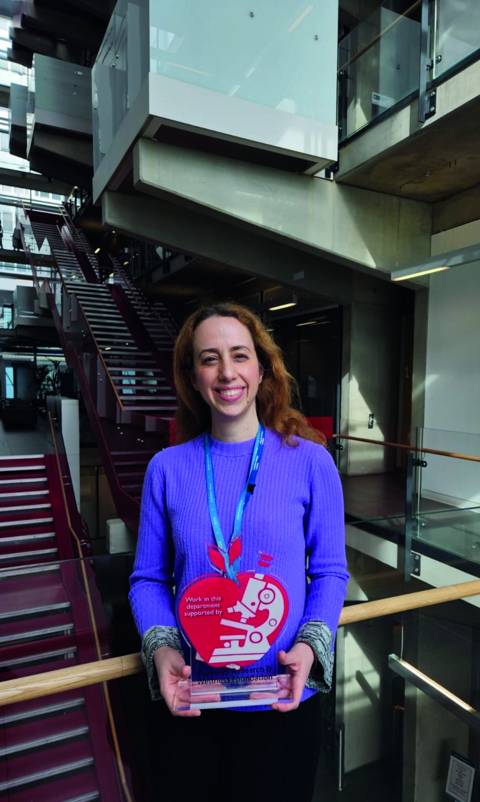
DRWF-funded research: Pump Priming Awards 2024
Six research awards have been made totalling £119,982 in the charity’s Pump Priming funding round for 2024 from a total of 20 applications.
The DRWF research programme is designed to support bright young researchers, as well as established institutions, as they strive to make the kind of life-changing breakthrough our diabetes community is hoping for.
Since the first DRWF research awards were made in 1999, the charity has committed more than £13 million to diabetes research in the UK and around the world.
The Pump Priming Awards invite the submission of research projects and proposals requiring funding in the field of diabetes.
These clinical or non-clinical research projects are up to two years’ duration and up to the value of £20,000 (no-cost extensions may be considered).

Dr Adaikala Antonysunil
Nottingham Trent University
£20,000
Title: Integrated omics to identify the epitranscriptomic interactions between methyl modifications of mature miRNAs and transcriptome in placenta due to micronutrient (B12) deficiency promoting diabetes in pregnancy
Lay summary: Obesity in pregnancy has adverse effects on both mother and baby and predisposes them to heart diseases later in life. Women of child-bearing age, pregnant, lactating and women adhering to vegan diet are at much higher risk of B12 deficiency, and their offspring are at elevated risk of low birth weight and preterm birth. This led to significant interest in understanding the maternal diet during pregnancy.
My research showed that pregnant women with low B12 have higher sugar and fat levels in the blood and develop more body fat, which are signs of higher risk for heart diseases in later life. However, the causal reason is unknown.
B12 is one of the key micronutrients turning the biological switch on/off for the methylation process, which is responsible for efficient functioning of small RNA molecules called microRNA that control genes and cellular process.
Here I propose that when B12 levels are deficient, the methyl groups normally added to the microRNA are reduced.
This results in dysfunctional microRNAs which could profoundly change gene/protein products and contribute to disease development. The aim is to characterise the methylation sites and identify the gene targets of microRNAs at the tissue level caused by low B12 using advanced technologies.
This approach will identify new pathways affected and detect new targets that could enable tailored therapies in specific patient subgroups to treat diabetes. Benefits are anticipated to enhance the potential for the individualised health care and management of patients with diabetes during pregnancy.

Dr Steven Millership
Imperial College London
£20,000
Title: Repurposing epidrugs for functional enhancement of human pancreatic beta cells
Lay summary: Insulin-secreting beta cells of the pancreas are what are destroyed or become dysfunctional in diabetes. To restore this functionality, methods have previously included transplanting isolated islets from donor patients. However, this has been met with problems of survival of lifelong immune suppression for the patient, and the survival of the implanted islets themselves.
Several research groups have made pioneering progress over the last decade by using stem cells originally from the patient that have a capacity to become any cell in the body and generating beta cell-like cells using a cocktail of various compounds over multiple stages of beta cell development in the laboratory. What these cells lack, however, is their “incomplete” levels of maturity to become a fully functional beta cell, as measured by the amount of insulin produced and their capacity to secrete it into the bloodstream.
We hypothesise that the missing element are pathways that regulate the expression of key beta cell genes (and therefore beta cell maturation) in the body, known as epigenetic pathways. We will screen a large number of commercially available compounds that target these epigenetic pathways known as “epidrugs” and assess their ability to enhance human beta cell maturation in a cellular model system.
Our goal is to interrogate the role that these novel epigenetic pathways have on beta cell functional maturation and ultimately to assess their ability to enhance the functionality of stem cell-derived beta cells prior to transplantation into patients with diabetes.

Dr Elizabeth Haythorne
Edinburgh University
£20,000
Title: Does partial inhibition of glucokinase protect human pancreatic beta-cells against glucotoxicity and glucolipotoxicity?
Lay summary: All forms of diabetes are characterised by a chronically elevated level of blood glucose (chronic hyperglycaemia, or high blood glucose), which results from insufficient secretion of insulin from the β-cells of the pancreas.
Type 2 diabetes is a progressive disease in which elevated blood glucose gradually damages the β-cell so that they release even less insulin, which leads to higher blood glucose levels and therefore further β-cell damage.
At time of type 2 diabetes diagnosis, it is often found that an individual’s capacity to produce adequate amounts of insulin in order to maintain healthy blood glucose levels has declined by as much as 50%. This inexorable decline in β-cell function leads to devastating secondary complications, such as heart, eye and kidney disease.
Although the current therapeutic strategies available for type 2 diabetes can reduce blood glucose either by enhancing insulin release (sulphonylureas, GLP-1 receptor agonists) or by increasing glucose clearance from the blood (insulin, metformin), none of these therapies provide any long-term benefit with regard to maintaining β-cell health and insulin secretion.
In people without diabetes, a rise in blood glucose causes glucose from the blood to be taken up by the β-cell where it is broken down by metabolism to produce a molecule called adenosine triphosphate (ATP), which is needed to stimulate insulin release.
In contrast, when blood glucose is chronically elevated, too much glucose is metabolised by the β-cell and eventually causes “blockages” in the metabolic pathway.
These “blockages” mean that glucose can no longer be metabolised to produce enough ATP to cause insulin secretion.
Thus, this proposal will investigate if the β-cell can be protected against the detrimental effects of chronic hyperglycaemia by lowering the amount of glucose which is metabolised by the cell down to the same level that happens in people without diabetes.
This novel approach will prioritise maintaining, or restoring, β-cell health and insulin secretion which will greatly reduce the risk of developing debilitating secondary complications.

James Russ-Silsby
University of Exeter
£20,000
Title: Gene discovery in transient neonatal diabetes to gain new insights into beta-cell development and function
Lay summary: Pancreatic beta cells make insulin, which controls blood glucose levels. When beta cells cannot make enough insulin, it leads to diabetes, a chronic and common condition affecting millions worldwide.
The aim of our project is to provide a deeper understanding of how beta cells function and develop. We will study individuals with rare types of diabetes caused by a single genetic defect. This helps us to better understand how beta cells work by allowing us to look at what happens when a single pathway is broken, offering a window into the broader functioning of beta cells.
The type of diabetes we will investigate is transient neonatal diabetes mellitus (TNDM). TNDM is diagnosed in babies who are unable to produce enough insulin during their development before birth and in early life. Uniquely, these children temporarily regain the ability to produce enough insulin in childhood but are then re-diagnosed with diabetes later, usually in adolescence or early adulthood.
Studying these babies, therefore, allows us to gain new information on the function and development of beta cells through time. We will look for new genetic defects causing TNDM to find the key genes responsible for the disease. We will use a powerful genetic technique called whole genome sequencing. This allows us to read all of the person’s DNA, meaning we can comprehensively look for the defects that cause the diabetes in people with TNDM.
We have already ruled out all of the known causes and selected individuals who have the strongest features of TNDM, meaning we are very likely to find new genes.
Our findings will provide key new information on the pathways that govern beta cell function and development.
This is the crucial first step towards identifying new drug targets for diabetes, bringing us a step closer to better management and treatment of this condition.

Dr Lazaros Foukas
University College London
£19,997
Title: Novel molecular determinants of brown adipose tissue inflammation in obesity and glucose dysmetabolism
Lay summary: Poor nutrition and population ageing are the main contributors to the current global epidemic of obesity and type 2 diabetes.
A pathological process underlying the development of these conditions is chronic inflammation of the adipose tissue.
There are two main types of adipose tissue: white adipose tissue that stores energy in the form of fat, and brown adipose tissue that contains a unique type of mitochondria (cellular organelles that produce energy), which can dissipate the energy from fat and glucose as heat.
Inflammation affects both the white adipose tissue and the brown adipose tissue.
Our research has shown that dietary fatty acids activate innate immune signalling pathways associated with inflammation and it aims to demonstrate that certain innate immune pathway components can be manipulated in a manner that promotes the energy dissipating activity of the brown adipose tissue.
This demonstration would provide proof-of-principle that pharmacological interventions altering the activity of innate immune inflammatory pathways can be used therapeutically to promote energy expenditure in a way that reduces body weight, improves insulin sensitivity and prevents or ameliorates type 2 diabetes.

Dr Kleopatra Alexiadou
Imperial College London
£19,985
Title: Semaglutide improves atherosclerosis via an anti-inflammatory action independent of weight loss
Lay summary: The majority of people with type 2 diabetes live also with overweight or obesity. One third of people living with diabetes are affected by cardiovascular disease, namely heart attacks and strokes. This is due to build-up of atherosclerosis plaques (accumulations of fats, cholesterol and immune cells) in artery walls. These plaques can cause arteries to narrow, blocking the blood flow and leading to a lack of blood supply, e.g. to the heart (causing heart attacks) or to the brain (causing strokes).
Semaglutide is a medication based on gut hormones and it was initially approved for the treatment of diabetes. Semaglutide is now also licensed for weight loss.
Some studies have shown beneficial effects for the cardiovascular system although the exact mechanism is not fully understood. Inflammation, where the immune system is activated to get rid of irritants and infection, is a normal process that exists to get rid of these irritants. Low grade inflammation is also associated with obesity, type 2 diabetes and atherosclerosis.
My hypothesis is that semaglutide has a beneficial cardiovascular profile via reducing inflammation and thereby slowing down atherosclerosis and that this is a direct effect of semaglutide and not merely a consequence of weight loss.
DRWF Research strategy
“Our vision is for a world free of diabetes and it is our goal to fund the very best research possible to ensure that we work towards a cure for the condition, investigating better treatments and management strategies, to ensure that people with diabetes are ‘staying well until a cure is found...’.”
Read more about DRWF-funded research
I would like to make a regular donation of
I would like to make a single donation of
There are lots of ways to raise money to support
people living with all forms of diabetes.
Bake, Swim, Cycle, Fly ... Do It For DRWF!
Fundraise with us
Recent News


